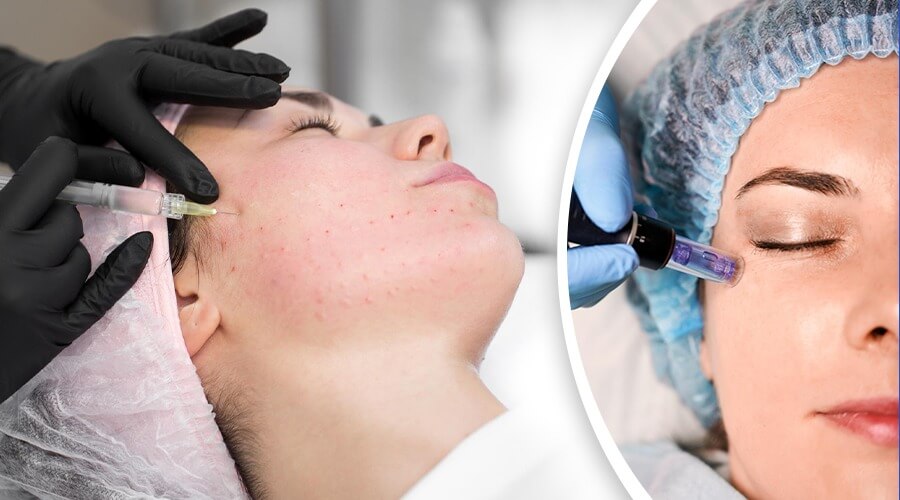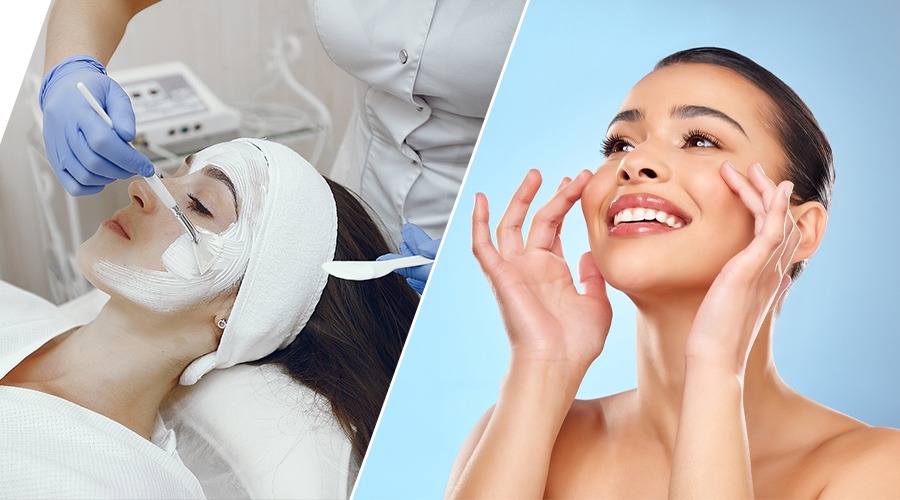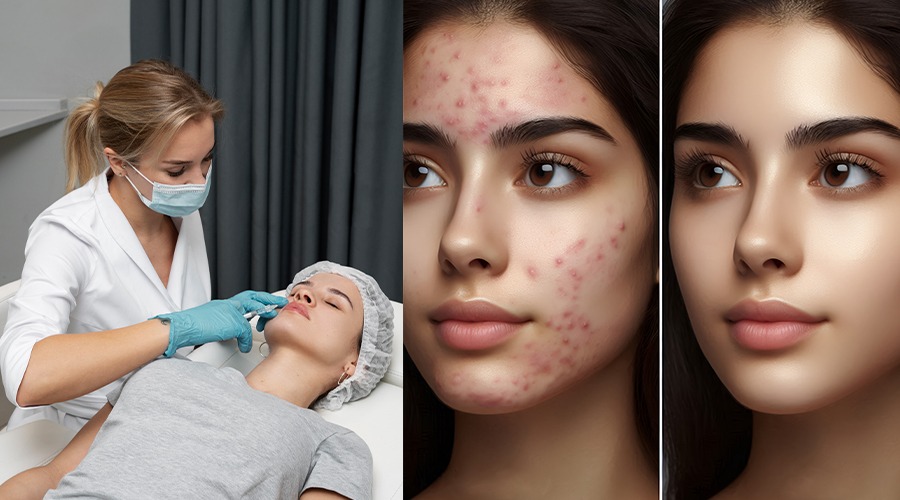
Hyperpigmentation Treatment
𝗧𝗵𝗲 𝗦𝗲𝗰𝗿𝗲𝘁𝘀 𝗼𝗳 𝗛𝘆𝗽𝗲𝗿𝗽𝗶𝗴𝗺𝗲𝗻𝘁𝗮𝘁𝗶𝗼𝗻 𝗧𝗿𝗲𝗮𝘁𝗺𝗲𝗻𝘁
Hyperpigmentation is a prevalent skin condition marked by the darkening of specific skin areas due to an overproduction of melanin. It affects people of all ages, genders, and ethnicities, often causing self-consciousness and frustration. However, with the right knowledge and approach, managing hyperpigmentation is possible. In this comprehensive guide, we'll delve into the causes, types, and effective treatment options for hyperpigmentation, empowering you to achieve a brighter, more even complexion.
𝗨𝗻𝗱𝗲𝗿𝘀𝘁𝗮𝗻𝗱𝗶𝗻𝗴 𝗛𝘆𝗽𝗲𝗿𝗽𝗶𝗴𝗺𝗲𝗻𝘁𝗮𝘁𝗶𝗼𝗻
To effectively address hyperpigmentation, it's crucial to understand its underlying causes. Melanin, the pigment responsible for determining skin color, is naturally produced by melanocytes, specialized cells found in the skin. These melanocytes distribute melanin to nearby skin cells, influencing the skin's coloration and providing protection against harmful UV radiation. Various factors can trigger excessive melanin production, leading to hyperpigmentation:
Sun Exposure: Prolonged exposure to ultraviolet (UV) radiation stimulates melanocytes, resulting in the formation of sunspots or age spots.
Hormonal Changes: Fluctuations in hormone levels, such as during pregnancy or due to oral contraceptives, can cause melasma, characterized by dark patches on the face.
Inflammation or Injury Post-inflammatory hyperpigmentation (PIH) occurs after trauma to the skin, such as acne, burns, or cuts, leading to localized darkening.
𝗧𝘆𝗽𝗲𝘀 𝗼𝗳 𝗛𝘆𝗽𝗲𝗿𝗽𝗶𝗴𝗺𝗲𝗻𝘁𝗮𝘁𝗶𝗼𝗻
Hyperpigmentation manifests in various forms, each with its unique characteristics:
Sunspots (Solar Lentigines): Also known as age spots or liver spots, these flat, brown spots typically appear on areas exposed to the sun, such as the face, hands, shoulders, and arms.
Melasma: Often referred to as the "mask of pregnancy," melasma presents as brown or gray-brown patches, primarily on the face, including the cheeks, forehead, and upper lip.
Post-Inflammatory Hyperpigmentation (PIH): This type of hyperpigmentation occurs following skin inflammation or injury, resulting in darkened patches or spots that persist after the initial condition resolves.
𝗧𝗿𝗲𝗮𝘁𝗺𝗲𝗻𝘁 𝗢𝗽𝘁𝗶𝗼𝗻𝘀 𝗳𝗼𝗿 𝗛𝘆𝗽𝗲𝗿𝗽𝗶𝗴𝗺𝗲𝗻𝘁𝗮𝘁𝗶𝗼𝗻
Treatment Options for Hyperpigmentation Addressing hyperpigmentation requires a multi-faceted approach, incorporating skincare interventions, sun protection, and in some cases, professional treatments. Let's explore these options in detail:
Skincare Routine: Establishing a consistent skincare routine is fundamental in managing hyperpigmentation. Look for products containing ingredients known for their skin-brightening and exfoliating properties, such as:
Vitamin C is renowned for its potent antioxidant properties, which not only combat free radicals but also play a role in inhibiting melanin production and brightening the skin. This multifaceted nutrient serves as a valuable addition to skincare routines, offering a range of benefits beyond its antioxidant capabilities.
Retinoids (Vitamin A Derivatives): Accelerate cell turnover, promoting the shedding of pigmented skin cells and stimulating the production of new, evenly pigmented cells.
Alpha Hydroxy Acids (AHAs) and Beta Hydroxy Acids (BHAs): Exfoliate the skin, removing dead cells and promoting cell renewal for a more even complexion.
When incorporating these ingredients into your skincare routine, start with lower concentrations to minimize the risk of irritation, gradually increasing as tolerated. Additionally, always follow up with a broad-spectrum sunscreen during the day to protect your skin from further UV damage.
𝗣𝗿𝗼𝗳𝗲𝘀𝘀𝗶𝗼𝗻𝗮𝗹 𝗧𝗿𝗲𝗮𝘁𝗺𝗲𝗻𝘁𝘀 𝗳𝗼𝗿 𝗛𝘆𝗽𝗲𝗿𝗽𝗶𝗴𝗺𝗲𝗻𝘁𝗮𝘁𝗶𝗼𝗻
For stubborn or persistent hyperpigmentation, seeking professional interventions from a dermatologist or skincare specialist may be necessary. These treatments target pigmentation at a deeper level, accelerating the fading process and revealing clearer, more even-toned skin. Several professional treatments are commonly used to address hyperpigmentation, includes:
𝐂𝐡𝐞𝐦𝐢𝐜𝐚𝐥 𝐏𝐞𝐞𝐥𝐬: A chemical solution is applied to the skin, causing exfoliation and peeling. This process removes the outer layers of pigmented skin, revealing brighter, more evenly pigmented skin underneath.
𝐋𝐚𝐬𝐞𝐫 𝐓𝐡𝐞𝐫𝐚𝐩𝐲: Various laser devices target melanin in the skin, breaking it down and stimulating the body's natural healing response. Over time, pigmented lesions fade, leaving behind clearer skin.
𝐌𝐢𝐜𝐫𝐨𝐝𝐞𝐫𝐦𝐚𝐛𝐫𝐚𝐬𝐢𝐨𝐧: This non-invasive procedure uses a handheld device to exfoliate the outer layer of the skin, reducing the appearance of dark spots and promoting a smoother texture.
Before undergoing any professional treatment, consult with a qualified skincare professional to determine the most suitable option for your skin type and concerns. Additionally, follow post-treatment care instructions diligently to optimize results and minimize the risk of complications.
𝗘𝗺𝗯𝗿𝗮𝗰𝗶𝗻𝗴 𝗬𝗼𝘂𝗿 𝗦𝗸𝗶𝗻’𝘀 𝗝𝗼𝘂𝗿𝗻𝗲𝘆
Managing hyperpigmentation is not a quick fix but rather a journey that requires patience, consistency, and a positive mindset. Celebrate small victories along the way, and remember that your skin's health and well-being are worth the effort. Embrace your skin's natural beauty at every stage of the process, and be kind to yourself as you work towards achieving your skincare goals.
Hyperpigmentation may seem daunting, but with the right knowledge and approach, you can effectively manage and minimize its appearance. By incorporating a comprehensive skincare routine, practicing diligent sun protection, and considering professional treatments when necessary, you can unveil a brighter, more even complexion and regain confidence in your skin. Keep in mind that every individual's skin is unique, and what proves effective for one person may not yield the same results for another. Be patient, stay consistent, and listen to your skin's needs as you navigate your hyperpigmentation treatment journey. With dedication and perseverance, you can achieve the radiant, even-toned skin you deserve.
𝗙𝗔𝗤𝘀 𝗼𝗳 𝗛𝘆𝗽𝗲𝗿𝗽𝗶𝗴𝗺𝗲𝗻𝘁𝗮𝘁𝗶𝗼𝗻 𝗧𝗿𝗲𝗮𝘁𝗺𝗲𝗻𝘁
𝐖𝐡𝐚𝐭 𝐜𝐚𝐮𝐬𝐞𝐬 𝐡𝐲𝐩𝐞𝐫𝐩𝐢𝐠𝐦𝐞𝐧𝐭𝐚𝐭𝐢𝐨𝐧?
Hyperpigmentation can be triggered by factors such as sun exposure, hormonal changes, and skin inflammation or injury, leading to an overproduction of melanin and darkening of the skin.
𝐇𝐨𝐰 𝐜𝐚𝐧 𝐈 𝐭𝐫𝐞𝐚𝐭 𝐡𝐲𝐩𝐞𝐫𝐩𝐢𝐠𝐦𝐞𝐧𝐭𝐚𝐭𝐢𝐨𝐧 𝐚𝐭 𝐡𝐨𝐦𝐞?
At-home treatments for hyperpigmentation often involve skincare routines incorporating ingredients like vitamin C, retinoids, and exfoliating acids. Additionally, diligent sun protection with broad-spectrum sunscreen is essential.
𝐀𝐫𝐞 𝐩𝐫𝐨𝐟𝐞𝐬𝐬𝐢𝐨𝐧𝐚𝐥 𝐭𝐫𝐞𝐚𝐭𝐦𝐞𝐧𝐭𝐬 𝐧𝐞𝐜𝐞𝐬𝐬𝐚𝐫𝐲 𝐟𝐨𝐫 𝐡𝐲𝐩𝐞𝐫𝐩𝐢𝐠𝐦𝐞𝐧𝐭𝐚𝐭𝐢𝐨𝐧?
While some cases of hyperpigmentation may respond well to at-home treatments, others may require professional interventions such as chemical peels, laser therapy, or microdermabrasion for more effective results.
𝐂𝐚𝐧 𝐡𝐲𝐩𝐞𝐫𝐩𝐢𝐠𝐦𝐞𝐧𝐭𝐚𝐭𝐢𝐨𝐧 𝐛𝐞 𝐜𝐨𝐦𝐩𝐥𝐞𝐭𝐞𝐥𝐲 𝐜𝐮𝐫𝐞𝐝?
While hyperpigmentation can often be improved or minimized with appropriate treatments, complete eradication may not always be achievable. However, with consistent care and maintenance, significant improvements in skin appearance and texture can be attained.
𝐈𝐬 𝐡𝐲𝐩𝐞𝐫𝐩𝐢𝐠𝐦𝐞𝐧𝐭𝐚𝐭𝐢𝐨𝐧 𝐭𝐫𝐞𝐚𝐭𝐦𝐞𝐧𝐭 𝐬𝐮𝐢𝐭𝐚𝐛𝐥𝐞 𝐟𝐨𝐫 𝐚𝐥𝐥 𝐬𝐤𝐢𝐧 𝐭𝐲𝐩𝐞𝐬?
Hyperpigmentation treatments can be tailored to suit various skin types, but it's essential to consult with a skincare professional to determine the most suitable approach based on individual skin concerns and sensitivities.





